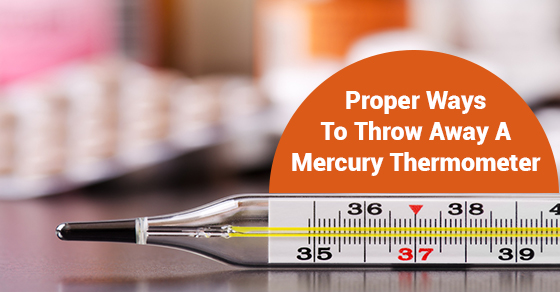How to Safely Throw Away Mercury Thermometers
One of the reasons the Canadian Pediatric Association does not recommend the use of mercury thermometers in the home is that, if these thermometers break, you and your child or children can be exposed to a toxic substance. Mercury is a liquid at room temperature, but it can quickly evaporate into a gas that has no smell. This gas then becomes toxic to all people within its radius and there have been many cases where children and parents have become ill due to mercury thermometers being broken and releasing mercury into homes. It’s the reason why it’s now recommended that all mercury thermometers are disposed of safely—in this post we’ll guide you on the disposal process.

Determine If It’s a Mercury Thermometer
Before planning disposal, confirm if a thermometer contains mercury. A mercury thermometer is a calibrated glass tube with a silver-white or grey liquid at the tube’s center.
- Look for a “mercury-free” sign on the thermometer. If it contains this label, then it’s not a mercury thermometer, and you can dispose of it along with the ordinary waste.
- Look for liquid in the thermometer. If the thermometer doesn’t have any liquid, then it’s not a mercury thermometer, and you can put it in your household trash bin.
- Check if the liquid is silver-white or grey. If the liquid is another colour — for instance, red — it is likely dyed alcohol or other safer alternatives.
If you assessed that your thermometer contains mercury, plan its disposal carefully.
How to Dispose of a Mercury Thermometer
Do not throw your mercury thermometer into the garbage or flush it down the toilet. Mercury is a toxic substance. If not disposed of properly, it can leak into the air and water supply. Mercury contamination can harm your family and the people in your area.
Here’s how to throw the mercury thermometer away safely.
Research the Right Facilities
Search for hazardous household waste facilities in your area that are equipped to handle toxic substances like mercury. If you can’t find any, check plumbing or hardware stores, they also offer safe disposal sites.
Pack the Thermometer Properly
Place the thermometer in a puncture-resistant, non-breakable, tightly sealed container. Plastic bottles and canisters with lids work well.
Don’t place them in large containers, as the thermometer might roll around and break during transit.
Label the Container
Label the container “Mercury Thermometer,” so it will be appropriately handled by the people who will receive them.
Bring the Mercury Waste to the Facility
Drop off the waste at the facility. There, the mercury thermometer will be disposed of using machinery that’s designed to prevent toxic release.
Common Questions on Mercury Thermometer Disposal
The following are common questions regarding the mercury thermometer disposal process:
- How do I determine if my thermometer uses mercury?If your thermometer is made from glass, it’s likely that it also contains mercury. Mercury thermometers also have a silver bulb as opposed to a red, green, or blue bulb.
- What do I do if I believe mercury has been spilt at home?If any mercury has leaked from the thermometer, it’s important that leak is cleaned quickly. Call a local cleaning company to discuss the cleanup process: don’t attempt to handle the thermometer without expert guidance.
- What are common signs of mercury poisoning?While it’s unlikely that you’ll to suffer significant health effects from the breakage of a mercury thermometer, it’s important to recognize the signs of potential poisoning. These signs include shortness of breath, chest pains and shaking.
By learning more on the mercury thermometer disposal process, you can help ensure your home remains safe over the coming years. To discuss mercury thermometer disposal services with a trusted specialist, call our expert team today!
